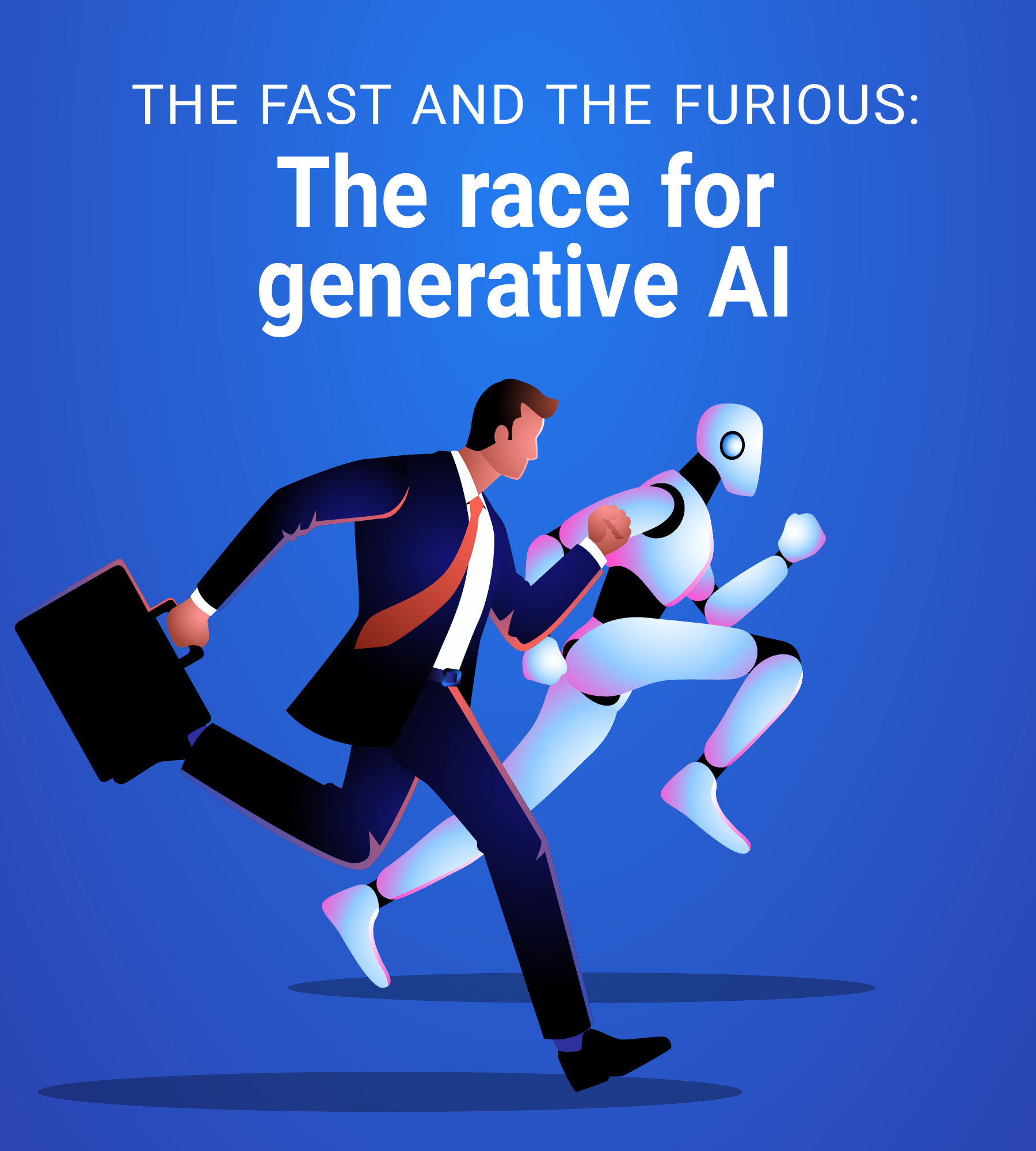Language
You can read the magazine in one of the following languages
The generative AI landscape continues to evolve rapidly, driven by the dynamic interplay between those pushing the technology forward at breakneck speed and those insisting on tangible, scalable solutions.
To borrow the title of a blockbuster Hollywood franchise, the showdown between these forces might be described as ‘the fast’ against ‘the furious’.
The ‘fast’ are represented by systems integrators (SIs), service providers and tech vendors that are relentlessly pushing the boundaries of what’s possible.
The ‘furious’ are end users – organizations and individuals – who seek swift benefits but also scalability and a productive, satisfied workforce.
SIs, service providers and tech vendors are racing to innovate, develop and deploy AI solutions that meet current market demands and anticipate future needs. They are pioneering cutting-edge tech by continuously refining algorithms, enhancing computational efficiencies and expanding AI capabilities.
These stakeholders operate in a highly competitive environment where speed is critical. A Bloomberg Intelligence report projects the industry to expand at a compound annual growth rate (CAGR) of 42 percent over the next 10 years, with demand for generative AI products potentially adding about US$280 billion in software revenue.
An S&P Global Market Intelligence report also foresees a massive expansion of the generative AI software market, predicting a CAGR of 58 percent and revenue of US$52.2 billion in 2028.
Consulting firms expect significant revenues in 2024 from advising businesses on AI deployments. According to the Financial Times, the Chief Executive of BCG said the consulting firm expects to generate one-fifth of its revenues in 2024 from helping corporations integrate AI into their operations and processes.

Consulting firms expect significant revenues in 2024 from advising businesses on AI deployments.
Last year, consulting firm EY announced it had completed a US$1.4 billion investment into AI and had also created its own large language model, EY.ai EYQ.
Attempting to harness the AI boom, companies are creating alliances with established and upcoming tech vendors, including cloud providers, AI developers and software and hardware producers.
Investments are also being fueled by venture capital. According to EY, global venture capital investments in generative AI in the first quarter of 2024 were US$3 billion. The amount is forecast to reach US$12 billion by the end of this year.
Detailing the AI investment sprees of Meta, Google, Amazon Web Services, Microsoft and IBM, as well as hundreds of other tech vendors, would take another article. Or even a book.
Generative AI adoption gaps continue to persist in industries and regions. According to IDC’s 2024 ‘Future Enterprise Resiliency and Spending Survey’, just four percent of Asia–Pacific organizations have “already introduced several generative AI enhanced applications/services abilities into production and are focused on expanding use enterprise-wide”.
This is contrasted against 20 percent and 24 percent adoption rates in North America and Western Europe, respectively.
That said, generative AI deployments are expected to grow significantly across the board in the coming years as organizations come to terms with TINA, or ‘there is no alternative’.

The faster companies bring new AI models or services to market, the better their chances of capturing share and establishing themselves as leaders in the field.
The faster companies bring new AI models or services to market, the better their chances of capturing share and establishing themselves as leaders in the field. The ‘fast’ approach is characterized by agile development cycles, substantial investments in research and development, and strategic partnerships that enable rapid deployments.
The integration of AI into existing systems and workflows is a complex task that requires meticulous planning and execution. SIs play a crucial role in ensuring that AI solutions are seamlessly embedded into the fabric of business operations so that organizations can leverage AI’s full potential without disruptions to their core activities.
However, the ‘fast versus furious’ war won’t be settled by a triumph of the most efficient model, graphics processing units or other tech. The competition will only be settled when end users in the real world truly believe they can benefit from this technology and start updating their business strategies and operating models – and opening their wallets – to accommodate generative AI solutions.
On the other end of the spectrum are the end users whose expectations and demands are becoming ‘furious’.
These are businesses and individuals who recognize the transformative potential of generative AI and are eager to utilize it to achieve scalability and enhanced productivity. They are driven by the need to stay competitive, optimize operations and deliver superior customer experiences.
For these end users, generative AI is not about adopting technology; it’s about achieving concrete, measurable outcomes.

For these end users, generative AI is not about adopting technology; it’s about achieving concrete, measurable outcomes.
These users seek solutions that can be quickly scaled to meet their needs, whether it’s processing vast amounts of data, generating insightful analytics or automating complex tasks. For them, AI solutions must deliver benefits almost immediately and be able to grow in tandem with the organization’s needs.
These users are also focused on ensuring their workforce is productive and satisfied. They do not want to see generative AI adoption lead to employee alienation or disempowerment.
Generative AI has the potential to augment human capabilities, reducing mundane and repetitive tasks and enabling employees to engage in more meaningful and creative work. Such a shift can enhance productivity and contribute to higher job satisfaction and employee retention rates.
Being ‘furious’ means being smart about investment, tech and risks – so dare to be furious.
Factors that limit the expansion of generative AI use by organizations include:
• A lack of skills or expertise
• A lack of clear use cases or initial offerings that align with business needs
• Concerns about AI accuracy and/or potential toxicity
• Concerns that generative AI could threaten an organization’s control of data and its intellectual property assets
• Challenges related to data availability and quality
SIs and tech vendors must prioritize user experience. They must ensure their solutions are intuitive and seamlessly integrate into existing workflows.
End users must remain adaptable and open to the iterative nature of AI development. They need to understand that initial deployments might require refinements and adjustments.
Bridging the gap between ‘fast’ innovators and ‘furious’ end users requires channeling the rapid advancements in AI technology into scalable, user-centric solutions.
Effective communication, continuous feedback loops and collaborative development processes are key if AI is to ultimately lead to a more productive and technologically empowered society.

Jan Burian
Contributor Collective Member
Jan Burian is a global analyst, author, speaker and Associate Vice President, Head of IDC Manufacturing Insights EMEA. His primary research areas encompass digital transformation, management and leadership, along with analyzing the geopolitical impacts on manufacturing and global supply chains. Jan has authored over 30 thought leadership articles that delve into topics such as digital transformation, the influence of AI and generative AI, and the future landscape of operations. For more information visit https://www.idc.com/getdoc.jsp?containerId=PRF005307
